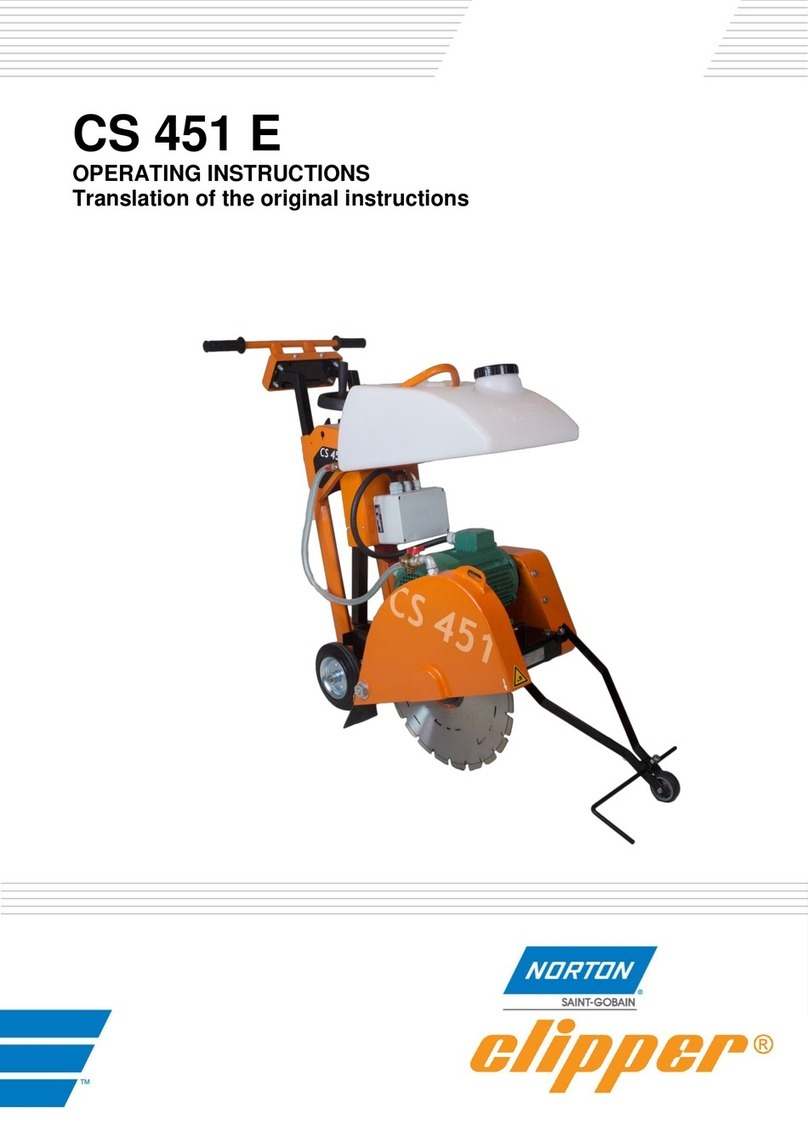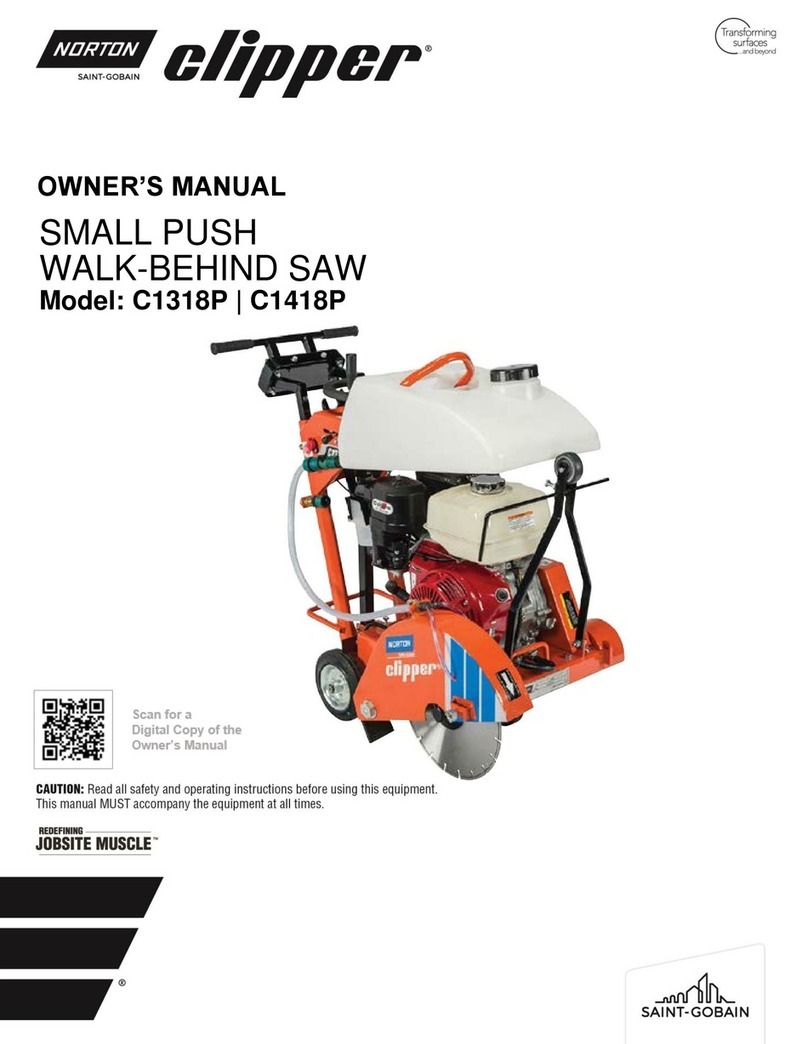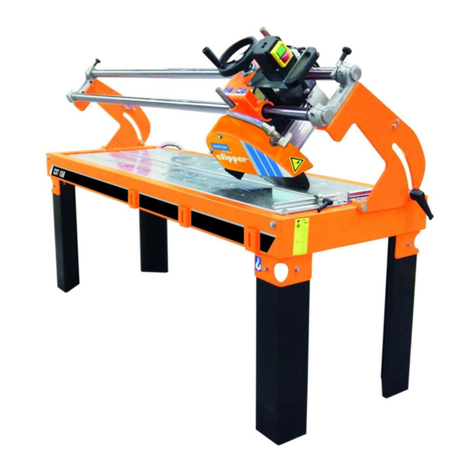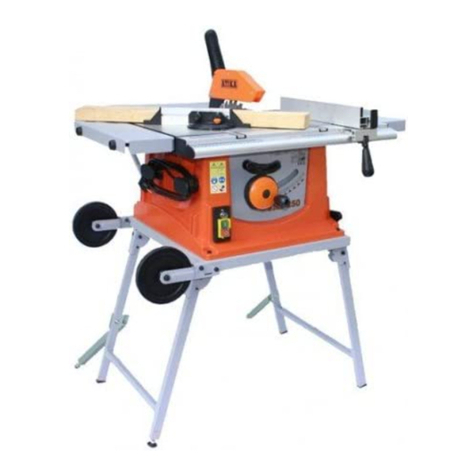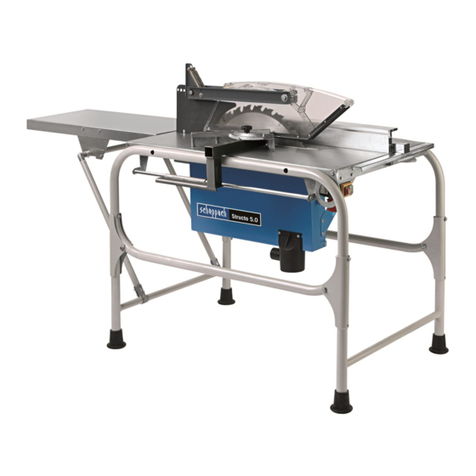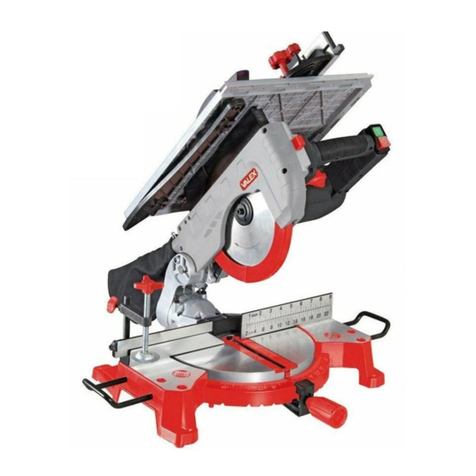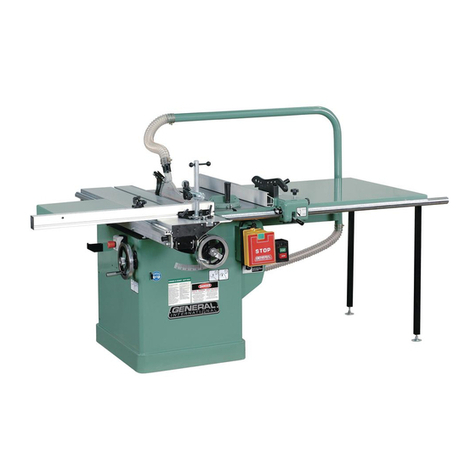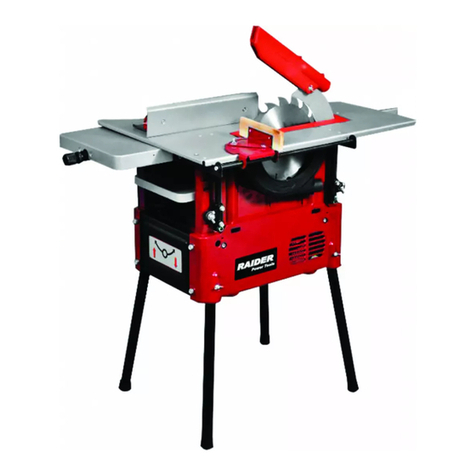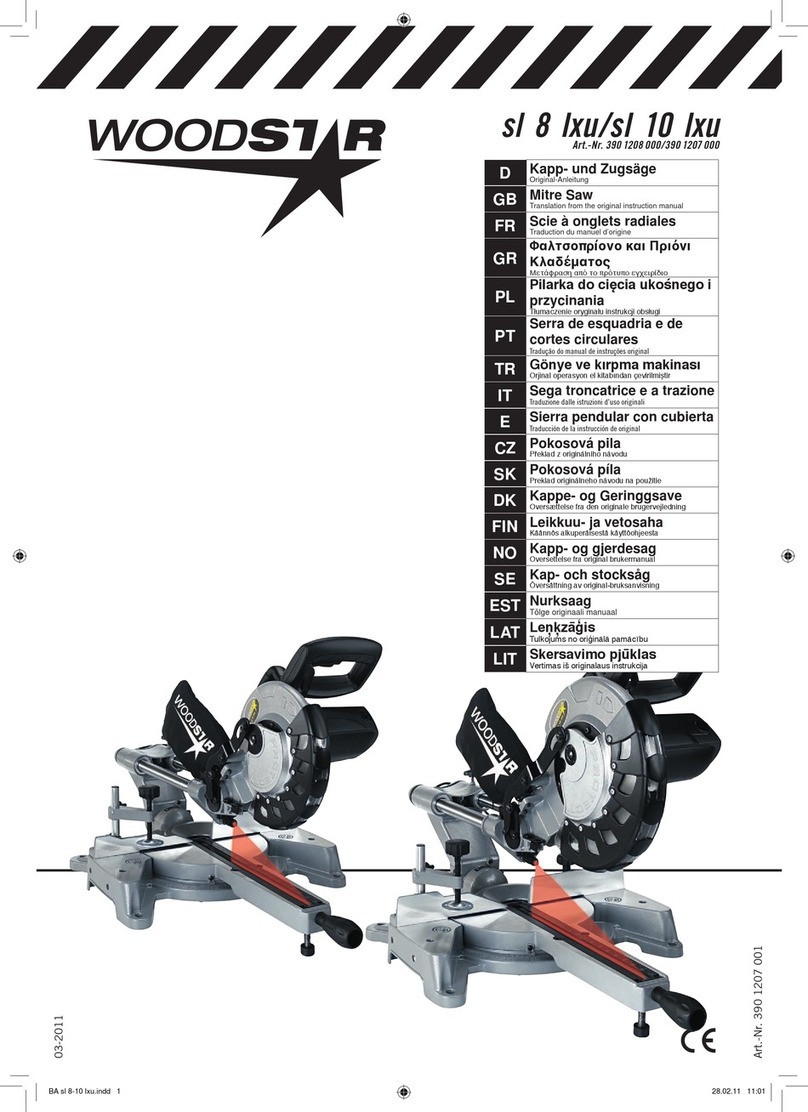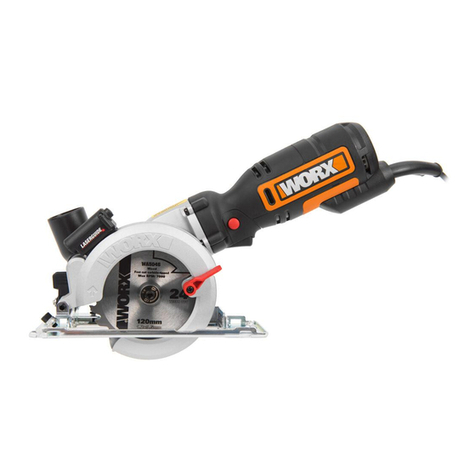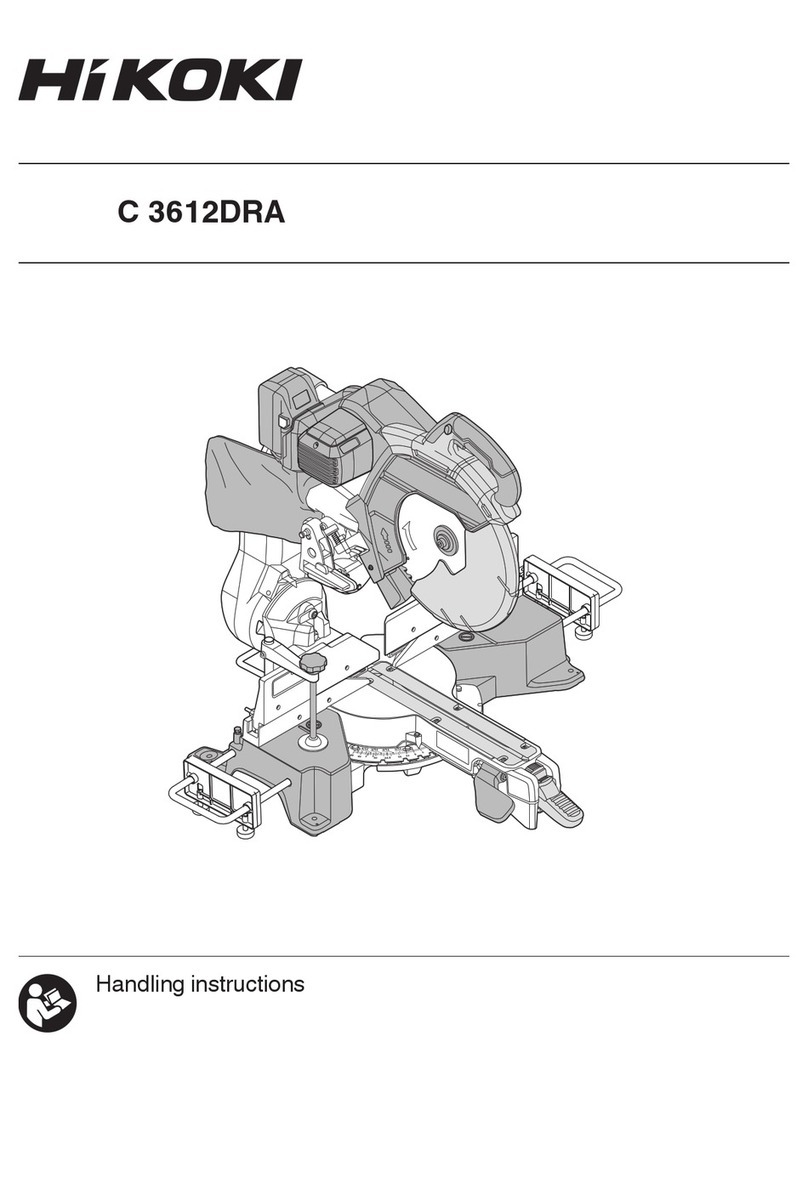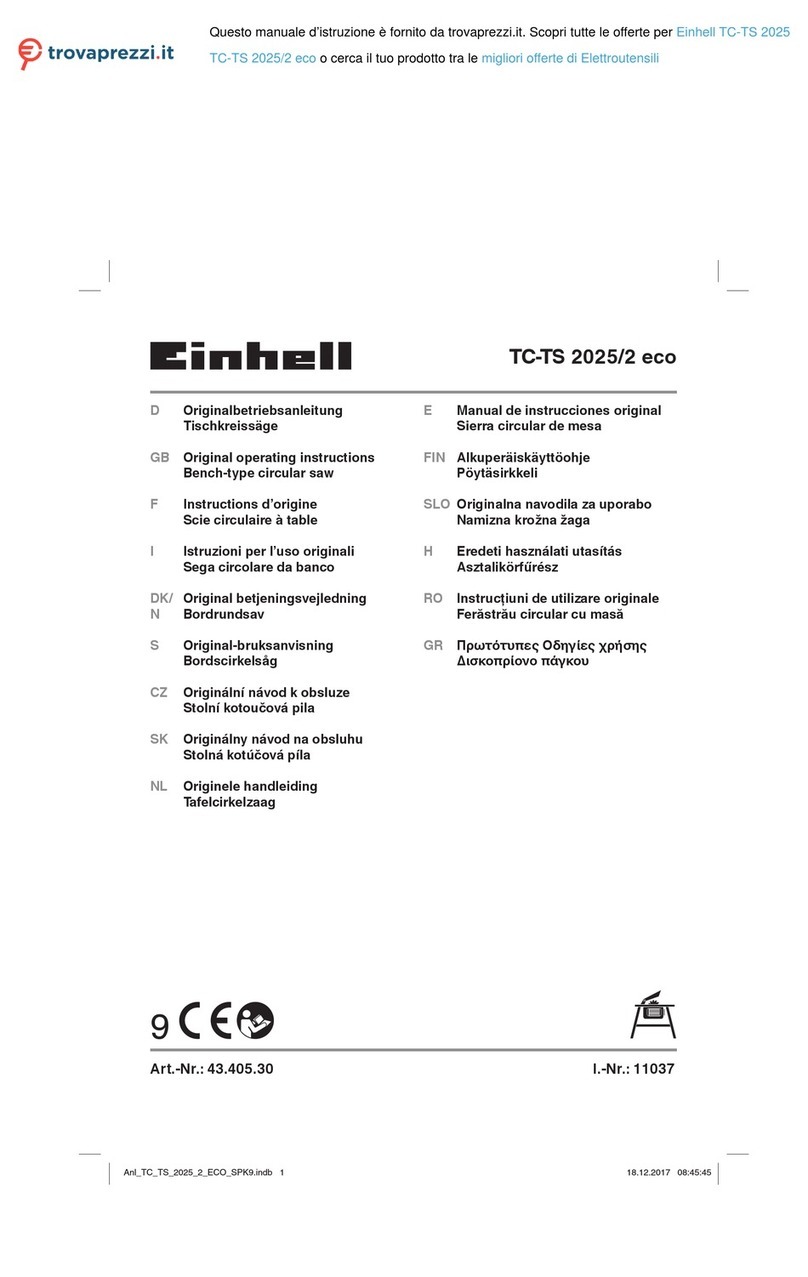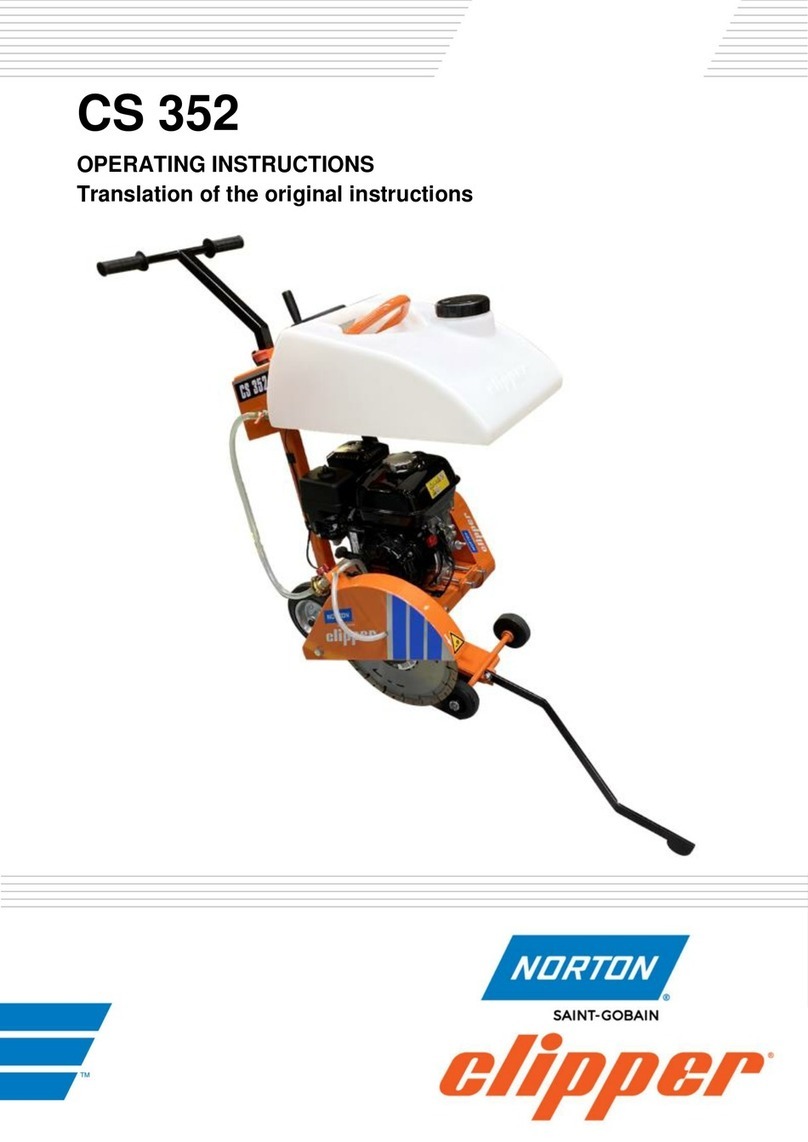Norton Clipper C914P User manual

1
OWNERS
MANUAL
Small Concrete Saw
Models:
C914P
FORM: C914P rev 8-2020

2
WARRANTY
Norton warrants all products manufactured by it against defects in
workmanship or materials for a period of one (1) year from the date of
shipment to the customer.
The responsibility of Norton under this warranty is limited to
replacement or repair of defective parts at Norton's Gainesville,
Georgia factory, or at a point designated by it, of such part as shall
appear to us upon inspection at such point, to have been defective in
material or workmanship, with expense for transportation borne by the
customer.
In no event shall Norton be liable for consequential or incidental
damages arising out of the failure of any product to operate properly.
Integral units such as gasoline engines, electric motors,batteries,
tires, transmissions, etc., are excluded from this warranty and are
subject to the prime manufacturer's warranty.
This warranty is in lieu of all other warranties, expressed or implied,
and all such other warranties are hereby disclaimed.
Important: Before placing equipment in operation, record the following
information.
MODEL:_________ SERIAL NO.___________
PURCHASE FROM: _____________________
ADDRESS: ____________________________
CITY_______ STATE ______ ZIP ________
TELEPHONE NO. ______________________
Before using this equipment, make sure that any person using it
reads and understands the instructions in this owner’s manual.

3
Table of Contents
CONTENTS PAGE
I. Preparation 4-11
A. Safety Precautions 4-6
Dust and Silica Warning 5
B. Assembly 7-9
C. C914P Series Concrete Saw Specifications 10
D. Engine Precautions 11
E. Pointer Alignment 11
II. Operation 12-20
A. Blade Installation 12-16-
B. Starting The Engine 16-18-
C. Water Supply 18-19
D. Operating The Saw 19-20
E. Cutting Technique 20
III. Maintenance 21-
A. Engine 21-23
B. Wiring Diagram C914P 9 HP Honda 24
C. Bearings 25
D. V-Belts 25-32
Adjust The C914P Belt Tension 26-29-
Belt Alignment 29
Main Causes of Belt Failures 30
E. Depth Control 31-32
F. Inspection and Cleaning 32
IV. Parts List Section 32-48
A. Ordering Information 33
B. Parts Drawing and Service Parts List 34-48
Depth Control Group 34-35
Blade Guard Group 36-37
Blade Shaft and Engine Group 38-39
Main Frame and Pivoting Frame Group 40-41
Belt Guard Group 42
Handle Bar Group 43
Pointer Group 44
Water Tank Group 45-46
Decals 47-48
Read Owner’s Manual Before Use
Safety Alert Symbol: Information Following This Symbol Is
Very Important.
Use Only Norton Diamond Blades

4
I. PREPARATION
A. Safety Precautions
Important! The following safety precautions must always be observed.
Hazard Symbols
Fuel (gasoline) is extremely flammable and its vapors can
explode if ignited. Store gasoline only in approved containers,
in well-ventilated, unoccupied approved areas, and away from
sparks or flames. Do not fill the fuel tank while the engine is hot
or running. Do not start the engine near spilled fuel. Never use
the fuel as a cleaning agent
Engine components can get extremely hot from operation. To
prevent burns, do not touch the engine or related parts while the
engine is running or immediately after it is turned off. Never
operate the engine with any heat shields or guards removed.
Keep all guards in place when operating any piece of equipment
Keep hands, feet, hair, and clothing away from all rotating parts
Lethal Exhaust Gas: use only in well ventilated areas. Engine
exhaust gases contain poisonous carbon monoxide, which is
odorless, colorless, and can cause death if inhaled. Avoid
inhaling exhaust fumes, and never run the engine in a closed
building or confined area.
Never tamper with the governor components of settings to
increase the maximum speed. Severe personal injury and
damage to the engine or equipment can result if operated at
speed above maximum. Always obey the maximum speed
rating of blade.
DO NOT LIFT THE SAW BY THE HANDLE
BARS

5
Dust and Silica Warning
Grinding/cutting/drilling of masonry, concrete, metal and other materials can
generate dust, mists and fumes containing chemicals known to cause serious or
fatal injury or illness, such as respiratory disease, cancer, birth defects or other
reproductive harm. If you are unfamiliar with the risks associated with the
particular process and/or material being cut or the composition of the tool being
used, review the material safety data sheet and/or consult your employer, the
material manufacturer/supplier, governmental agencies such as OSHA and
NIOSH and other sources on hazardous materials and make certain to comply
with all product warnings and instructions for the safe and effective use of the
material being cut. California and some other authorities, for instance, have
published lists of substances known to cause cancer, reproductive toxicity, or
other harmful effects.
Control dust, mist and fumes at the source where possible. In this regard use
good work practices and follow the recommendations of the manufacturer/supplier,
OSHA/NIOSH, and occupational and trade associations. Water should be used
for dust suppression when wet cutting is feasible. When the hazards from
inhalation of dust, mists and fumes cannot be eliminated through engineering
controls such as vacuum and/or water mist, the operator and any bystanders
should always wear a respirator approved by NIOSH/MSHA for the material being
cut.
Use Approved:
Eye Protection Hearing
Protection
Respiratory
Protection
Head Protection

6
1. Before mounting any blade on the saw, the blade should be inspected for
any damage which might have occurred during shipment, handling or
previous use.
2. The blade collars and arbors should be cleaned and examined for damage
before mounting the blade.
3. The blade must be properly fitted over the arbor with the drive pin on the
outside collar projecting through the drive pin hole on the blade and
inside collar.
4. The blade shaft nut, which is a left-hand thread nut, must be tightened
securely against the outside blade shaft collar.
5. The blade must be operated within the specified maximum operating
speed listed on the blade.
6. Turn water control valve to full to provide adequate coolant (4 to 6 gallons
per minute) for diamond blades and wet cutting abrasive blades.
Insufficient coolant could result in severe blade breakage or diamond
segment separation.
7. The blade guard must be in place with the nose guard down and locked
when the saw is running.
8. The operator should wear safety glasses and any other appropriate safety
equipment.
9. When starting the saw, the operator should stand away and to the side of
the blade.
10.If for any reason the saw should stall in the cut, raise the blade out of the
cut. Check the outside blade shaft collar and nut for tightness. Inspect
the blade for damage before restarting the saw. Use caution when
resuming a cut. Be certain that the blade is in alignment with the previous
cut.
11.During cutting operations do not exert excess side pressure on the
handles as a method of steering. Do not force the blade into the cut by
lowering the blade too fast or by pushing the saw too fast.
You Are Responsible For Your Safety!!!

7
I. PREPARATION
B. Assembly
The C914P compact concrete saw is shipped completely assembled and ready
for use except for Handle Bar, Diamond Blade, Gasoline, and Engine Oil.
Inspect the saw for shipping damage. If any damage is found, contact the
shipper immediately and file a freight claim. Norton Clipper is not responsible
for any freight-related damages.
Handle Bar Lifting Bale
Depth Adjustment
Hand Wheel
Front Pointer
(
Cuttin
g
Guide
)
Belt Guard
Blade Guard
Engine On/Off
Switch
Water Tank
Engine Choke,
Fuel Shut Off, and
Throttle Controls
Engine Air Cleaner

8
Remove the saw from the pallet. Inspect the machine for concealed shipping
damaged. Read and understand ALL instruction included in this manual.
Failure to understand and follow the instruction covered in this manual can
result in injury to persons or damage to the machine.
DO NOT LIFT THE SAW BY THE HANDLE BARS
Loosen the Handle Bar Retaining Jam Nuts and Bolts. Remove the Handle
Bars from the Frame and rotate 180° so that the Hand Crips will be towards the
Operator. Slide the Handle Bar Assembly into the frame, adjust to the
Operator’s desired height, and align the nearest Hole in the Handle Bar
Assembly with the top Retaining bolt. Tight both Handle Bar Retaining Bolts
and Tighten the Jam Nuts. See Figure: Handel Bar Assembly
¾” Garden Hose
Fitting
Quick Detach
Water Fitting with
Valve
Handle Bar Attachment
Hardware
En
g
ine On/Off Switch
Wrench and
Wrench Holder
Serial Number Plate
Water Tank Quick
Detach Fittin
g
s Blade Guard Water
WYE and Nozzels

9
Handle Bar Assembly
Level the cutting frame and check the engine oil level and add if required (See
Engine Manual) and add fuel (See Engine Manual). NOTE: Do not install the
blade until it is time to use the saw. ANSI regulations prohibit the
transportation of any concrete saw with the blade installed.
Handle Bar Installation;
DO NOT LIFT THE SAW BY THE HANDLE BARS
Handle Bar Assembly
Handle Bar Attachment
Hardware
Handle Bar Attachment
Hardware

10
C. C914P Series Concrete Saw Specifications
C914P
Dimensions/Weight
Length (Working) – in (mm) 57-55/64" (1,469)
Length (Transport) – in (mm) 35-37/64" (929)
Pointer Length – in (mm) 12-47/64" (323)
Width – in (mm) 37-59/64" (963)
Height – in (mm) 21-9/32" (541)
Weight Created – lbs. (kg) 198.4 (90.6)
Weight Uncreated – lbs. (kg) 169.4 (77)
Engine
Engine Mfg. Honda
Model GX370
Spec No. GX270QXC
Engine Type Single Cylinder 4 Cycle
Horse Power – Gross hp (kW) 9 HP (6.7kW) @ 3,500 RP<
Max Torque – Gross – ibf-ft (Nm) 14 (19) @ 2,500 RPM
Cooling System Air
Oil Capacity – US qt (l) 0.29 (1.1)
Fuel Capacity – US qt (l) 5.6 (1.1)
Fuel Type Unleaded Gasoline (86 pump octane)
Low Oil Sensor Yes
Air Filtration Three Stage Cyclone
Characteristics
Max Blade 14" (350)
Depth of Cut 14” (356 mm) – in (mm) 4-5/8 (117)
12” (305 mm) – in (mm) 3-5/8 (92)
10” (254 mm) – in (mm) 2-5/8 (67)
1-5/8 (41)
Arbor Bore – in (mm) 1” (25.4 mm)
Blade Shaft Locking Device Machined Into Flats On Blade Shaft
Blade Shaft Speed – RPM 2,840
Blade Shaft Diameter – in (mm) 7/8" (22)
Depth Control Hand Wheel With Screw Feed
Depth Lock Standard
One (1) Revolution of Hand Wheel ¼” (6.4mm) Change of Depth
Front Wheel DxWxB – in (mm) 3-15/16 x 1-3/8 x 0.59 (100 x 35 x 15)
Rear Wheel DxWxB – in (mm) 7-7/8 x 1-49/64 x 0.79 (200 x 45 x 20)
Number Of Belts Three (3) XPZ610 Belts
Blade Guard Type Hinged, All Steel Construction
Side of Cut Right
Lifting Bale Yes
Water Hose Connector Standard Garden Hose With Flow Control Valve
Water Tank Capacity – gal (l) 6.6 (25)
Recessed Rear Wheels Standard
Adjustable Handle Bars – in (mm) Yes 9-29/64 (245)
Stay Level Handel Bar System Yes
* = Horse power and Torque ratings are Gross Horse power and are supplied by the engine manufacturer. Actual output of the engine will vary due to many
factors including operational speed of engine, environmental conditions, maintenance, fuel, and other variables. Saint-Gobain Abrasives, Inc. makes NO
claim to actual or gross horse power and torque ratings.

11
D. Engine Precautions
Prior to attempting to operate the engine, read the information
contained in the engine owner's manual. An engine owner’s manual is
supplied with every gasoline powered concrete saw.
1. Check Oil: Add oil if low. Refer to the engine owner's manual for the
recommended SAE viscosity grades. Capacity of oil is 1.16 US quarts (1.1
liters)
2. Check Fuel: Fill if low. Use only unleaded gasoline with a pump sticker
octane rating of 86 or higher is recommended. Never use an oil and
gasoline mixture!
3. Air Cleaner: Never run the engine without the air cleaner! Rapid engine
wear will result from contaminants being drawn through the carburetor and
into the engine.
4. Engine Starting: Refer to the engine owner's manual additional proper
engine starting procedure.
E. Pointer Alignment
1. Use a straight edge, and carefully mark a line 12 feet long on a smooth level
surface.
2. Place the saw blade on the marked line, move the saw to the center of the
marked line and then lower the blade until it is about 1/16” above the
marked line
3. Measure from each end of the saw frame to insure that the frame is parallel
to the marked line. Adjust the saw as needed.
4. With the blade centered on the marked line and the saw frame parallel to
the marked line, lower the front pointer.
5. Adjust the pointer by bending it until is aligned with the marked line.

12
II. OPERATION
A. Blade Installation
1. Disconnect the spark plug.
2. Pull the Blade Guard Locking Pin Way from the Blade Guard and Pivot
the Blade Guard out of the Way see Figure: Blade Guard Locking Pin
for details. NOTE: The Blade Guard Locking Pin is under spring
tension and will automatically move towards the Blade Guard, if it does
not immediately replace the Blade Guard Locking Pin before using the
saw.
Blade Guard Locking Pin
3. Pivot Blade Guard UP to provide access to Blade Shaft Nut and Blade
Collars see Figure: Blade Attachment Components for details.
Blade Guard Locking Pin
Blade Guard
Pull Pin Away from Blade Guard to UNLOCK
Move Towards Blade Guard to LOCK

13
Blade Attachment Components
4. Remove the blade shaft nut, (Turn clockwise),and remove the outside
collar. NOTE: The Blade Shaft has a flat for use with a 19mm wrench
to prevent rotation.
5. Clean off any foreign particles on the clamping surfaces of both collars and
on the mounting surface of the blade.
6. Place the blade on the blade shaft, lining up the drive pin hole in the blade
with the drive pinhole in the inside collar. The C914P will only accept
Diamond Blades with a Maximum Diameter of 14” (350mm) and a Bore of
1” (25.4mm) and a maximum core thickness of 1/8” (3.1mm) see Figure:
Blade Installation for details. NOTE: Maximum 14” (350mm) Blade can be
used with the C914P, if the blade does not fit under the Blade Guard then
the diameter is greater than 14” (350mm). ALL Diamond Blades have a
direction of rotation indicated on the blade either, install the blade so that
the direction of rotation is clock wise. Use only Norton Diamond Blades
Loose Collar
Blade Shaft Nut
Left Hand Thread
Blade Shaft
Blade Guard
Tight Collar

14
Blade Installation
For Best Performance Use Only Norton Diamond Blades
Specified For the Material Being Cut.
7. Slide the outside blade shaft collar onto the blade shaft. The drive pin
on the outside collar must project through the drive pin hole in the blade
and into the inside collar.
8. Tighten the blade shaft nut (counter-clockwise) securely against the
outside collar. See Figure: Blade Installed on C914P for details.
Diamond Blade
14” (350mm) Max
Diamete
r
Loose Collar
Blade Shaft Nut
Left Hand Thread
Direction of Rotation
Drive Pin Hole
Blade Shaft
Tight Collar

15
Blade Installed on C914P
9. Lower the Blade Guard, verify that the Blade Guard Locking Pin Aligns
with the Slot in the Blade Guard Bayonet and Reattach the Blade Guard
Locking Pin by pushing the Locking Pin Towards the Blade Guard see
Figure: Locking The Blade Guard for details. NOTE: The Blade
Guard Locking Pin is under spring tension and will automatically move
towards the Blade Guard, if it does not immediately replace the Blade
Guard Locking Pin before using the saw.

16
Locking The Blade Guard
10. Reconnect the spark plug.
One Revolution of the Hand Wheel equals ¼” (6.4mm) change of cut depth
B. Starting the Engine
1. Refer to the engine owner's manual for detail starting procedures.
2. Always cut with engine rpm in the full throttle setting.
Before starting, insure that the blade is properly installed,
all guards are in place and in safe operating condition, and
that the Blade is not in contact with any surface or object.
Also verify that the area where the work is to be performed
is clean, safe, and has proper ventilation and lighting.
Always located and properly mark all water, gas, and
electrical services before beginning any work.
Never transport any machine with the Blade installed.
Move Towards Blade Guard to LOCK
Blade Guard Locking Pin
Blade Guard
Blade Bayonet

17
Turn the Fuel Control To the ON Position
Move the choke lever to the CLOSED position.
NOTE: The Choke may not be needed if the engine
is warm or the air temperature is high.
Move the Engine Throttle Slightly to the Left
Turn the ON/OFF Switch to the ON position. NOTE:
The Emergency Stop Switch is located on the
machine’s Console.
Pull the starter grip lightly until you feel resistance,
then pull briskly. CAUTION: Do not allow the starter
grip to snap back against the engine. Return it gently
to prevent damage to the starter.
As the engine warms up, gradually move the choke
lever to the OPEN position (fully to the right)
Position the throttle control lever for the maximum
engine speed (fully to the Left).

18
To stop the engine, move the Throttle Control Lever fully to the Forward
Position (fully to the right) and Engine Switch to the OFF position. Turn the fuel
valve to the OFF position.
Never transport the machine with the Fuel Valve in the ON
position. Never Store the machine with the Fuel Valve in the
ON position.
Never Transport a machine with the blade installed.
C. Water Supply
The C914P is designed for use with either a ¾” Garden Hose Fitting and
pressurized water source or by using the included Water Tank.
Pressurized source:
A Pressurized Water Source such as a city water supply off of a building or
external water tank with a water pump capable of providing 4 to 6 gallons (15.1
to 22.7 liters) of water per minute will provide the best dust control and cooling
of the blade. Using a Pressurized Water source providing 4 to 6 gallons (15.1
to 22.7 liters) of water per minute meets all OSHA Silica control requirements.
¾” Garden Hose
Fitting
Quick Detach
Water Fitting with
Valve
Water Tank Quick
Detach Fittings
Water Tank
Water Tank Cap

19
1. Verify that the Quick Detach Fitting with Valve is connected to the ¾”
Garden Hose connector.
2. Turn the Water Control Valve to full "ON" when using wet cutting blades.
The required flow rate is 4 to 6 gallons (15.1 to 22.7 liters) per minute.
3. Follow ALL instructions under the Section “D. Operating The Saw”
Water Tank source:
The C914P included Water Tank is designed to provide some dust control for
when a Pressurized Water source is not available. The Water Tank also
increases the machine overall weight which assist at cutting at deeper depths.
It is preferred to use the Pressurized Water source as it will provide the
required water flow rates over a longer time period than the Water Tank.
Please note that when using the Water Tank it is recommended that the
operator use a OSHA approved respirator to protect from Silica Dust.
1. Fill the Water Tank to the bottom of the filler neck with Water.
2. Replace the Water Tank Cap
3. Verify that the Quick Detach Fitting with Valve is Connected to the Water
Tank Fittings
4. Follow ALL instructions under the Section “D. Operating The Saw”
5. Adjust the Quick Detach Fitting with Valve’s water control valve so that
enough water is covering the blade to reduce the water to your required
level. NOTE: The Operator and anyone around the machine MUST wear a
respirator that meets OSHA Silica Control Requirements and follow ALL
OSHA Silica Control Regulations.
D. Operating the Saw
1. For blade installation instructions see section II. Operation sub heading
A. Installing the Blade. For the engine starting instructions, see the
Engine manual and follow the instructions located in section II. Operation
sub heading B. Starting the Engine.
2. Check the Engine Oil level. See Engine Manual for details.
3. Raise the saw to the full upright position. Do not let the blade come in
contact with the ground.
4. Maneuver the saw to the desired starting point.
5. If wet cutting, connect the water supply to the saw. See section B. Water
Connections for details.
6. Follow the instructions for starting the engine found in the Engine manual.
7. If wet cutting, turn on the water supply at the source and then open the
water valves on the saw. Make sure that there is a minimum of 4-6 gallons
(15.1 to 22.7 liters) per minute of water flow!!
8. Be sure the engine is running at full throttle!!!

20
9. Slowly lower the blade by rotating the hand wheel clockwise until the
desired depth of cut is reached. Use a reasonable rate of feed. Do not
force the blade into the cut!!
10. When the end of the cut is reached, slowly raise the blade out of the cut by
rotating the Hand Wheel counter-clockwise until the blade is at least one
(1) inch above the ground.
11. Only move the saw in reverse with the blade in the raised position.
13. When moving the saw to a new location, be sure the blade is not touching
the ground. Always pay close attention to where you are moving and
where the blade is at all times.
E. Cutting Technique
Lower the blade into the concrete to the required depth by turning the hand
wheel clockwise.
Reduce the forward pressure if the saw begins to stall.
Note: For deeper cuts of 3: (76mm) or more, several cuts should be made in
incremental steps of 1-1/2 to 2 inches until the desired depth of cut is reached
this is known as Step Cutting. The C914P has a 4-5/8” (117.5mm) with a 14”
(355.6mm) blade many blades that are marketed as a 14” blade are 350mm
(13-3/4”) which will produce shallower cuts due to the overall diameter NOT
being 14” (355.6mm). NEVER cut full depth in a single path as this will cause
damage to any concrete saw blade, and damage drive belts. Burning of drive
belts is due to cutting full depth and is not covered under warranty.
Push the saw steadily forward using the front pointer as a guide. Exert enough
forward pressure so that the engine begins to labor, but does not slow down. If
the saw begins to stall, reduce the forward movement until full rpm is restored
to the blade. If the saw stalls, raise the blade out of the cut before restarting.
Avoid excessive side pressure or twisting of the blade in the cut.
Additional Guide Lines For Sawing:
Understand and follow all of the instructions in this owner’s manual.
If wet cutting, turn on the water supply so that there is a minimum of 4-6
gallons (15.1 to 22.7 liters) per minute of water flow!!
In critically hard aggregate, more than a single pass may be needed to cut
the desired depth.
If the saw stalls in the cut, immediately stop the forward speed and raise the
blade out of the cut. If this is not done the belts can fail or the blade may be
damaged.
Go slowly with a new blade until it opens up, that is, until the diamonds can
be seen and felt.
Other manuals for C914P
1
Table of contents
Other Norton Clipper Saw manuals
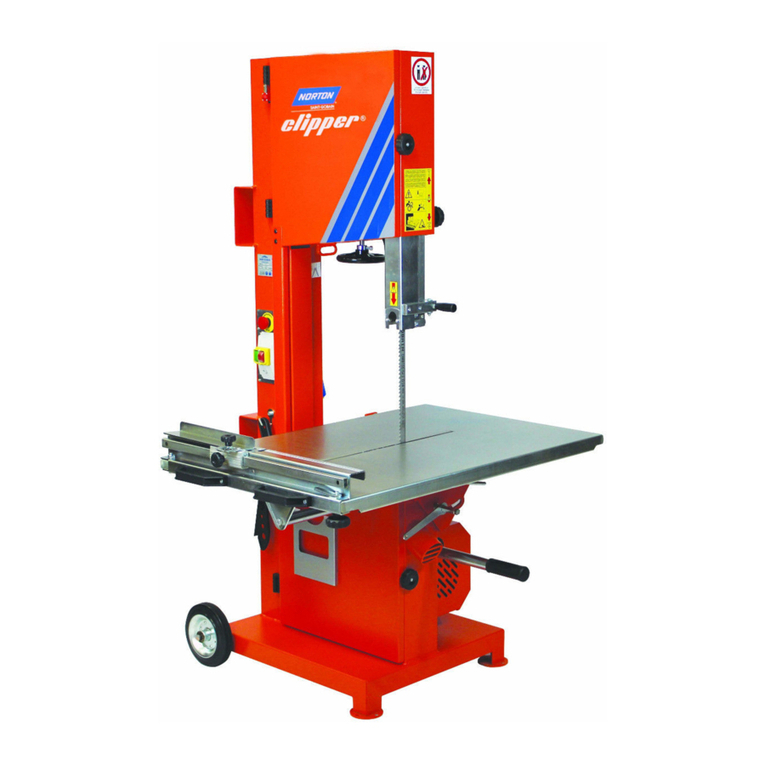
Norton Clipper
Norton Clipper CB 511 User manual
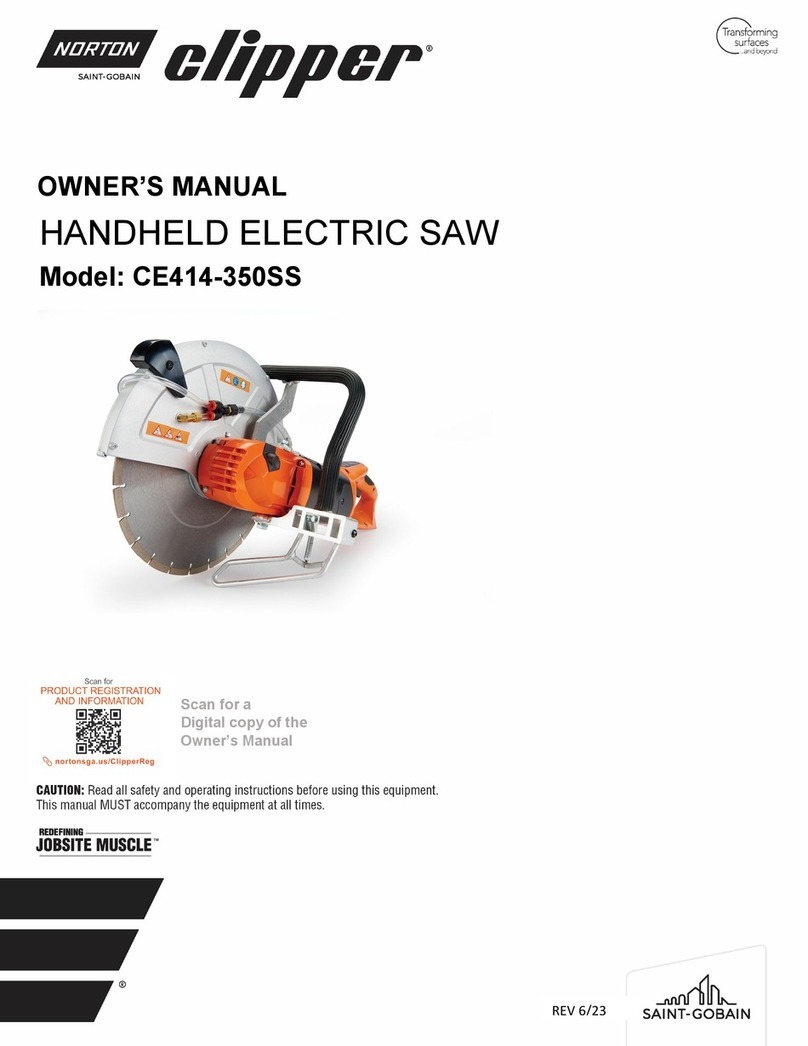
Norton Clipper
Norton Clipper CE414-350SS User manual
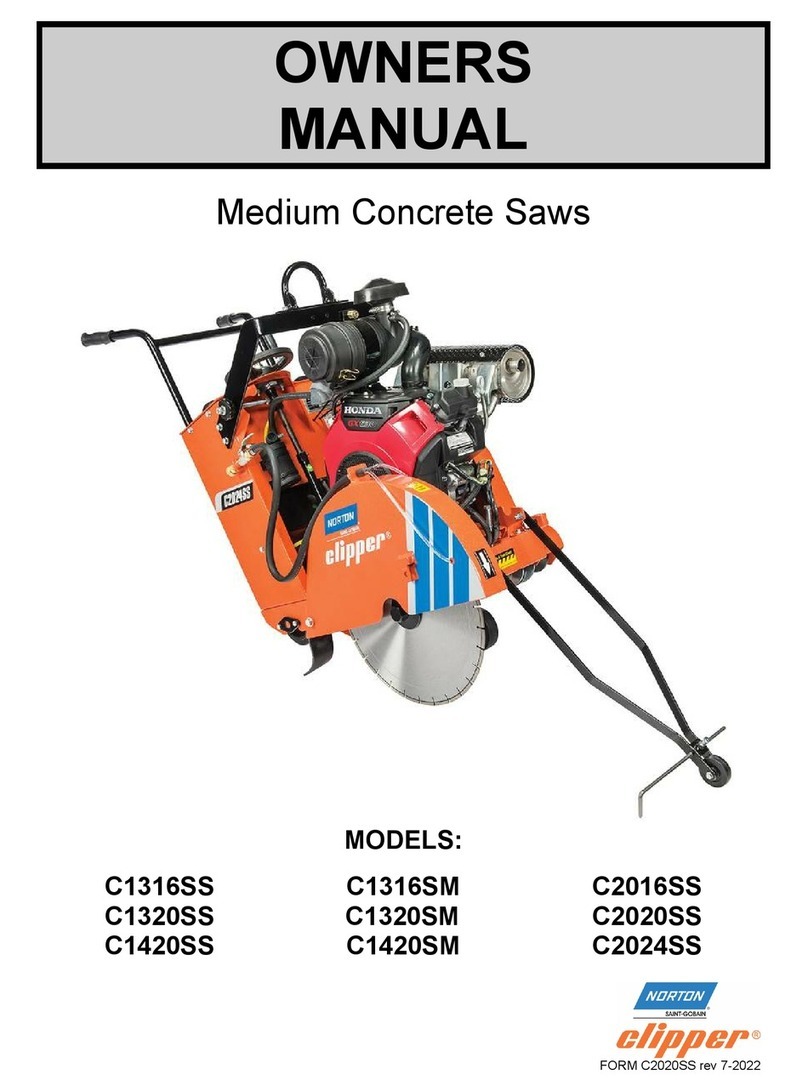
Norton Clipper
Norton Clipper C1316SS User manual

Norton Clipper
Norton Clipper CM 601 User manual

Norton Clipper
Norton Clipper CM 41 User manual
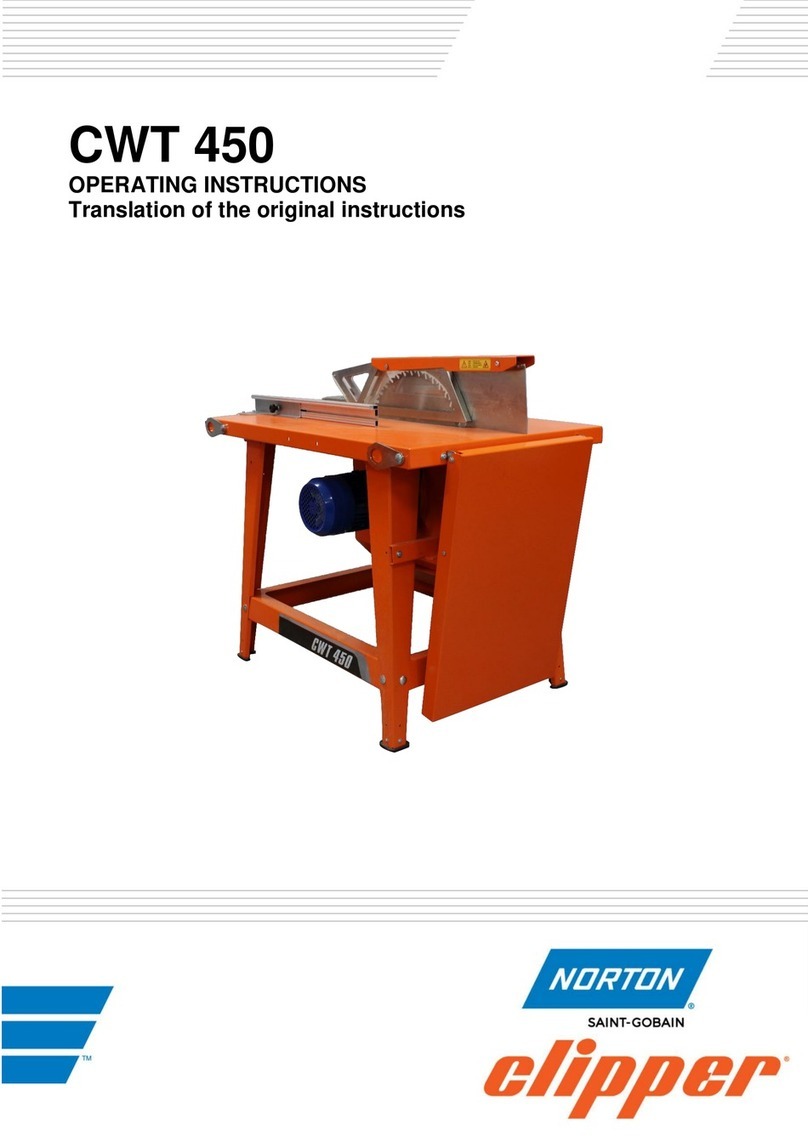
Norton Clipper
Norton Clipper CWT 450 User manual

Norton Clipper
Norton Clipper Pro-Cut BBM307 User manual
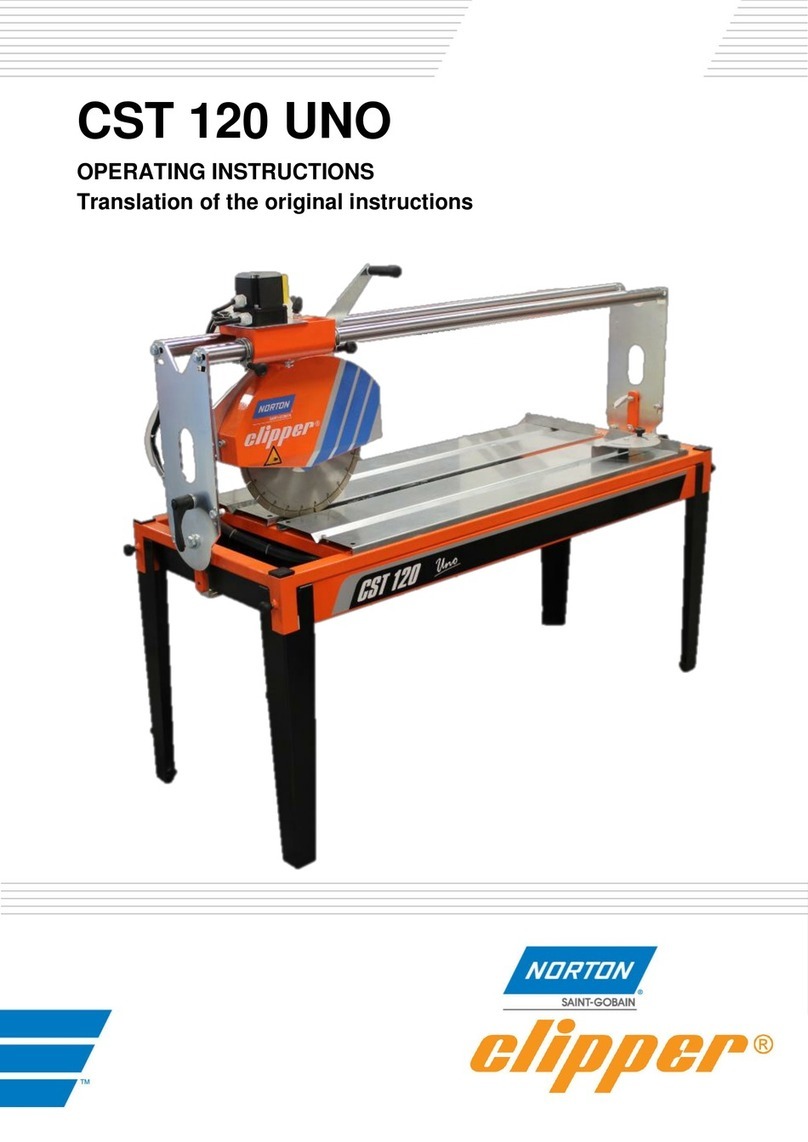
Norton Clipper
Norton Clipper CST 120 UNO User manual
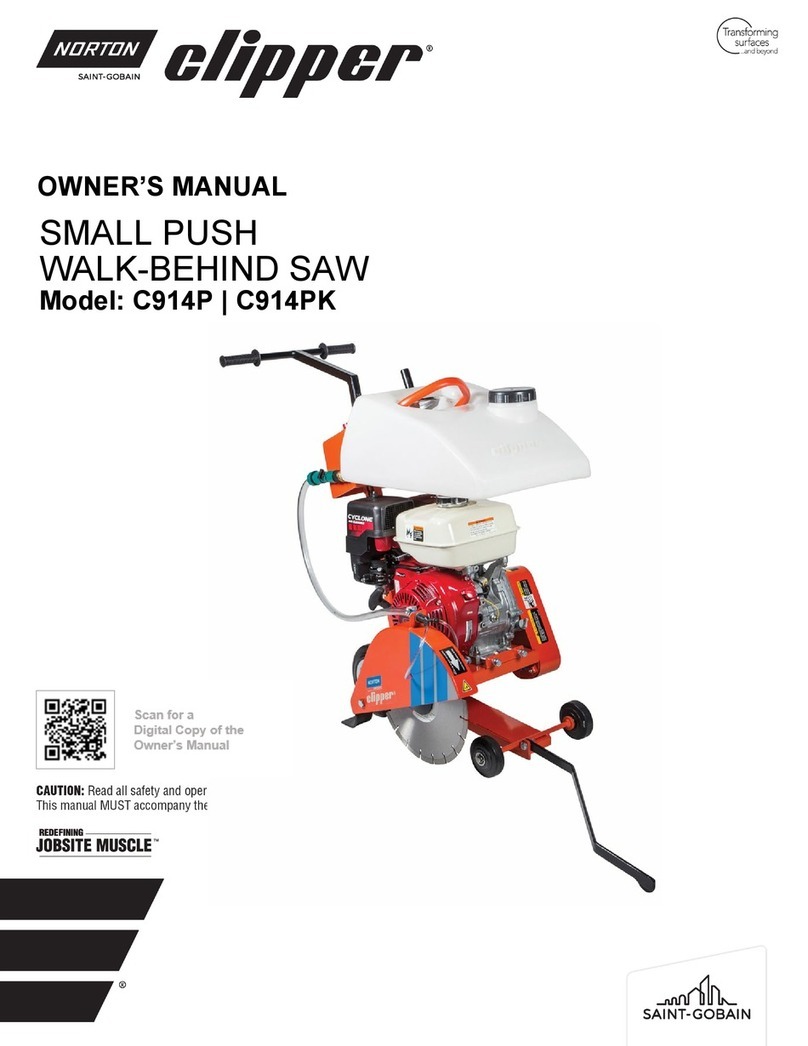
Norton Clipper
Norton Clipper C914P User manual

Norton Clipper
Norton Clipper CE414-350 User manual
